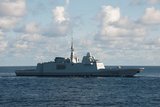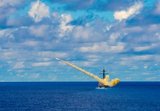UK, US ships conduct minehunting exercise
Four British ships together with several US ones participated in a four-day minehunting exercise as a warm-up for the International Mine Countermeasures Exercise, the UK Royal Navy announced on 31 March.
Minehunters HMS Middleton (Hunt class) and HMS Bangor (Sandown class) and their mother/support ship RFA Cardigan Bay as well as frigate HMS St Albans were tested along with US minehunter USS Gladiator, while the auxiliary tug USNS Catawba planted practice mines in the Gulf for the minehunters to find, neutralise or recover.
The exercise tested the forces’ ability to work together, conduct boardings and searches of suspicious vessels, eliminate targets with their guns, fend off air attacks, clear the mock minefield and put divers in the water.
Cmdr Jools Howe, in charge of the mine warfare battle staff, UK Royal Navy, said: ‘This is a perfect example of how successfully a multi-national force can integrate and work together to hone its skills in difficult and changeable environmental conditions. Understanding the nuances of each area is key as we work maintain freedom of navigation and ensure safety in the region.’
Related Equipment in Defence Insight
More from Naval Warfare
-
![US Navy to conduct an experimentation campaign with emerging tech in 2026 and 2027]()
US Navy to conduct an experimentation campaign with emerging tech in 2026 and 2027
The Technology Operational Experimentation Events will inform future requirements as the US Navy looks for innovative solutions across three key operational domains.
-
![US Navy to acquire micro-uncrewed underwater vehicles for ISR and coastal data collection]()
US Navy to acquire micro-uncrewed underwater vehicles for ISR and coastal data collection
The Naval Supply Systems Command is seeking authorised resellers of JaiaBot uncrewed underwater vehicles and multivehicle pods. The platforms will support undergraduate education at the US Naval Academy.
-
![NATO tests use of “undetectable, jam-proof” laser communication in maritime scenarios]()
NATO tests use of “undetectable, jam-proof” laser communication in maritime scenarios
As part of its effort to better prepare its capabilities for operations in contested and congested scenarios, NATO evaluated a Lithuanian ship-to-ship terminal designed to not be susceptible to enemy interference.
-
![US Navy advances with the Harpoon Service Life Extension Programme]()
US Navy advances with the Harpoon Service Life Extension Programme
The US Navy plans to improve Harpoon’s anti-ship and land attack capabilities by equipping the missiles with sensors and technologies required for succeeding in future battlespace.























